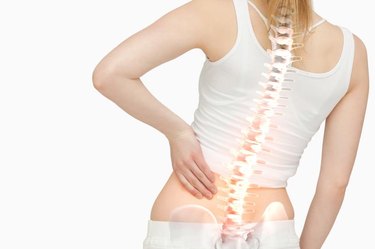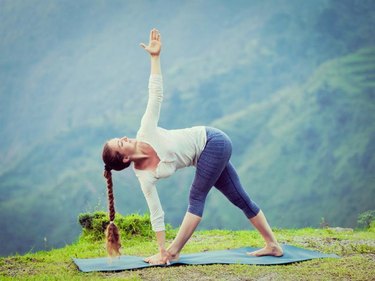
A healthy spine is imbued with a series of natural curves that describe an S formation. This natural curvature evolved as part of the spine's built-in shock absorbing system. Arthritis, certain genetic tendencies and plain old gravity are among the things that can distort the spine's curvature, causing pain and impairing mobility.
Yoga can do much to restore the spinal health, or at least to counter some of the negative effects caused by these conditions. However, while many poses may be beneficial, some could make it worse. So if you have a serious spinal problem, it's a good idea to consult with your orthopedist about doing yoga.
Video of the Day
Video of the Day
Read More: How to Lengthen the Spine with Yoga
Giving Your Slump the Bump
Excessive backward curvature of the thoracic spine -- the middle region of the back -- is called kyphosis. Years of slumping forward at a desk, in front of a computer screen or behind the wheel causes the pectoral muscles to become short and tight and the upper back muscles to become weak and slack. That leads to a slump that's permanent -- unless you take action to correct it.
If this is your problem, you'll want to emphasize backbending poses such as a Cobra, which is performed lying face down and bending upward as if you're doing a push-up from the waist. Also good is Locust: Lie face down, elevate your nose and sternum a few inches from the floor while stretching your arms toward lifted legs and feet.
Shoulder openers help to lengthen the pectoral muscles that can pull your thoracic spine forward. You can do a modified Bow Pose by standing in a doorway with your arms supported on either side and letting your body hang forward will accomplish this. You can also modify the stretch by hanging forward from the top of the doorway, too.
Away with Sway Back
At the other end of spectrum from kyphosis is lordosis, which is an excessive inward curve of the lower back. In its more severe form, it can give people that "swayback" appearance characterized by buttocks jutting outward and overall exaggerated posture. Weak abdominals and muscle tightness in the lumbar region are two of the main factors in this, so the first order of business is to strengthen the former and stretch the latter.
Boat is a good pose for strengthening the abdominal muscles, but it also works the hip flexors -- very important for posture because they connect the inner thighs to the front of the spine. Standing poses like Mountain and Eagle are also effective for correcting lordosis, especially if you engage your abs by bracing them as if you're about to take a punch in the gut. Bridge and other poses that involve tilting the pelvis forward stretch the erector spinae, which are the muscles that run along either side of the spine and can cause posture to contract when they're too tight.

Poses for Scoliosis
Scoliosis is a common condition that causes the spine to curve abnormally to one side or another, primarily affecting the thoracic region. Scoliosis is a serious condition that can cause pain and numbness, and it sometimes requires surgery. However, many have found that yoga is a powerful tool to help you live with it.
There are several kinds of scoliosis and it may take some trial and error to find the yoga regimen that works best for you. Fortunately, many yoga instructors are familiar with the condition and, in fact, more than a few embarked on the yoga path because they themselves have it.
In general, Cow pose is one of the top recommendations for opposing the condition because it restores mobility to the thoracic spine. Afterwards, perform Child's pose to counterbalance any twinges you may have incurred in Cow. Standing poses such as Revolved Triangle can also help straighten and elongate spinal muscles.
Persist and Be Patient
Most people who start doing yoga experience benefits almost immediately. However, how far yoga will take you to reverse abnormal curvature of the spine depends on many variables related to the severity and cause of the condition.
However, you might take from a 2001 University of California at Davis study. It had participantspractice 10 weeks of Hatha yoga training four times a week. Each practice included 50 minutes of asanas in addition to warm-up, meditation and breathing exercises. After the 10 weeks, participants muscle strength increased by as much as 31 percent, muscle endurance by 57 percent and flexibility by as much as 188 percent. While that's not a direct measure of the progress you'll make with your spine, it's an indication of yoga's power to put the body right.
A gradual approach to correcting excess curvature of the spine is usually safest, so you might begin with Hatha or Iyengar yoga before testing other, more vigorous styles such as Vinyasa.
Read More: Yoga and Spinal Fusion